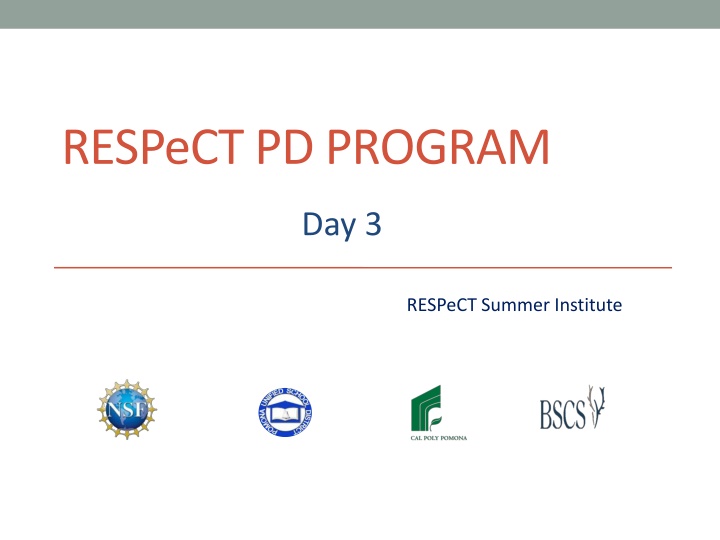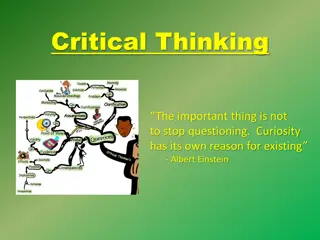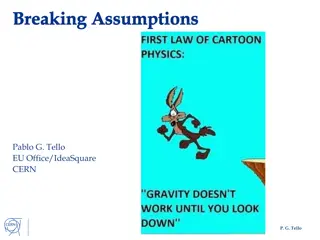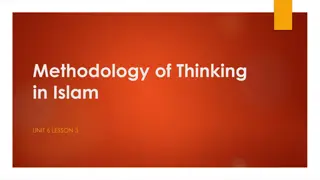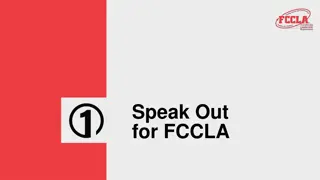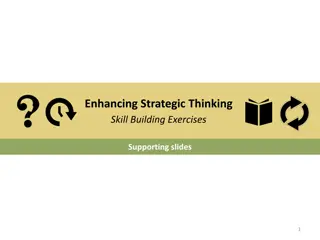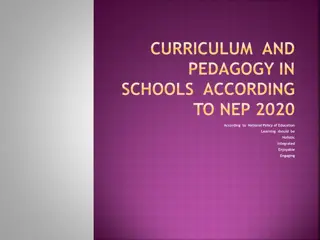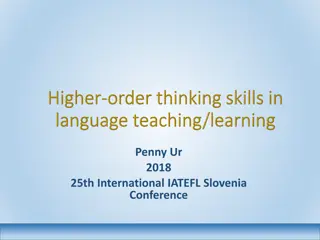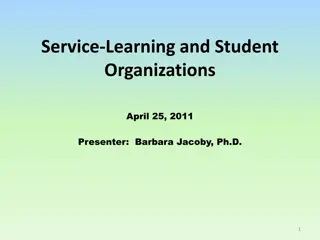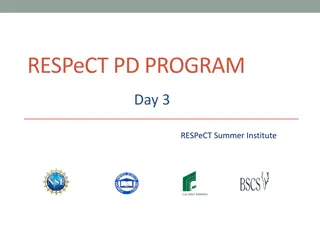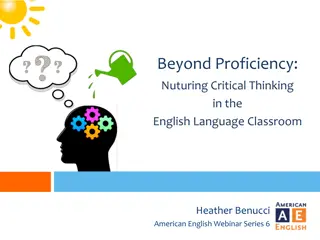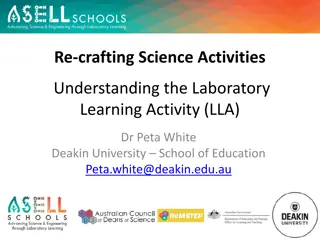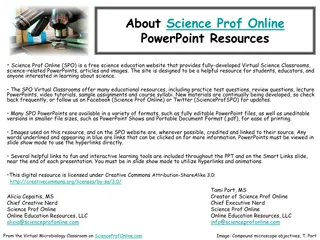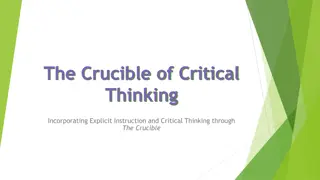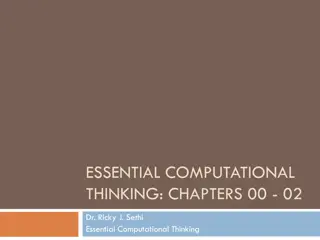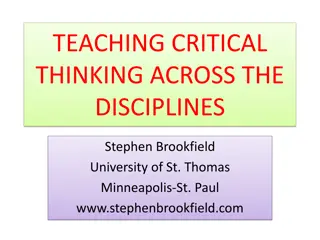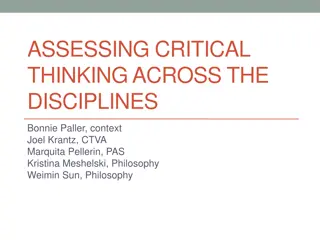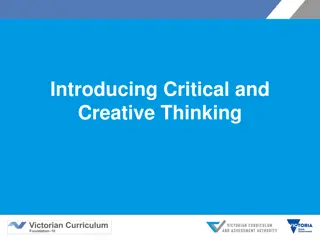Enhancing Science Learning Through Student Thinking Strategies
Explore Day 3 of the RESPeCT Summer Institute focusing on STL strategies, lesson analysis, traits variation, and student engagement in scientific thinking. Uncover trends in reflections, student questions, and activities that advance science learning without rote memorization. Delve into the purposes and key features of STL strategies 4 and 5, emphasizing data analysis, trait variation testing, and trait changes within populations.
Download Presentation

Please find below an Image/Link to download the presentation.
The content on the website is provided AS IS for your information and personal use only. It may not be sold, licensed, or shared on other websites without obtaining consent from the author.If you encounter any issues during the download, it is possible that the publisher has removed the file from their server.
You are allowed to download the files provided on this website for personal or commercial use, subject to the condition that they are used lawfully. All files are the property of their respective owners.
The content on the website is provided AS IS for your information and personal use only. It may not be sold, licensed, or shared on other websites without obtaining consent from the author.
E N D
Presentation Transcript
RESPeCTPD PROGRAM Day 3 RESPeCT Summer Institute
Agenda for Day 3 Day-2 reflections Focus questions Purposes and key features of STL strategies 4 and 5 Lesson analysis: STL strategies 4 and 5 Lunch Content deepening: variation in traits Summary, homework, and reflections
Trends in Reflections Lesson Analysis Science Content Learning
Todays Focus Questions How can analyzing data and constructing explanations help students move forward toward deeper understandings of science ideas? How can we design experiments to test for genetic and environmental causes of trait variation? How would biologists explain how a trait changes within a population over time?
The Student Thinking Lens: Moving Student Thinking Forward How can we advance students science learning without just telling them about science ideas and expecting them to memorize the concepts? By using STeLLA strategies 4 8 to engage students in making sense of the world around them.
The Student Thinking Lens: Moving Student Thinking Forward Strategies That Reveal Student Thinking Strategies That Move Student Thinking Forward 1. Elicit questions 2. Probe questions 3. Challenge questions 3. Challenge questions 4. Analysis and interpretation of data 4. Analysis and interpretation of data 5. Construction of explanations 5. Construction of explanations 6. Use and application of new ideas 6. Use and application of new ideas 7. Synthesis and summarizing 7. Synthesis and summarizing 8. Scientific communication 8. Scientific communication
The Student Thinking Lens: From Questions to Activities Look at the Summary of STeLLA Student Thinking Lens Strategies in the strategies booklet. What distinguishes strategies 1 3 from the rest of the Student Thinking Lens strategies?
STL Strategies 4 and 5: Purposes and Key Features Strategy 4 Strategy 5 What are the purpose and key features? What are the purpose and key features?
Relationships between Strategies 4 and 5 Discuss the question assigned to your group and be ready to share your ideas: Group 1: How is analyzing/interpreting different from describing observations? Group 2: How are strategy 4 and strategy 5 different? How are they related? Group 3: How are scientific explanation and scientific argumentation related? How are they different? How are arguments in science different from arguments in everyday situations? To support your responses, use the STeLLA strategies booklet and Quick Reference Tools for Strategies 4 and 5 (handout 3.1).
Practice Identifying Strategies 4 and 5 Examine student statements made during a science- class activity. Decide whether each statement represents the following: An observation An analysis or interpretation of the observations (e.g., describing a pattern) (strategy 4) An attempt to construct an explanation that has a claim, evidence, and/or reasoning that uses science ideas (strategy 5) An attempt to construct an argument (strategy 5) Refer to Practice Identifying Strategies 4 and 5 (handout 3.2).
Lesson Analysis Focus Question How can analyzing data and constructing explanations help students move forward toward deeper understandings of science ideas?
Lesson Analysis: Review Lesson Context Video Clip 1 Review the lesson context at the top of the transcript for video clip 1 (handout 3.3 in your PD program binder).
Lesson Analysis: Identify Strategy 4 Video Clip 1 Identify instances where the teacher or the students are engaged in analyzing and interpreting data and observations by clarifying key observations, identifying a pattern in the observations, identifying what needs to be explained, organizing data/observations, and/or trying to make sense of the observations (analyzing, interpreting). Discuss: How are these actions implemented in the video? Link to video clip 1: 3.1_mspcp_gr.3.variations.traits_wilde_L5_c1 Link to video clip 1: 3.1_mspcp_gr.3.variations.traits_wilde_L5_c1
Lesson Analysis: Analyze Strategy 4 and Reflect Analyze What student thinking is revealed in the video clip by engaging students in analysis and interpretation? Were any opportunities missed for engaging students in analyzing and interpreting data and observations? Reflect What did you learn about strategy 4 from analyzing this video clip? Did the analysis process focus your attention on aspects you might not have noticed before? If yes, what is one example? Video Clip 1
Strategy 5 Practice: Explanation and Argumentation Analyze the genetics sample transcript in the strategies booklet to find evidence of students engaged in constructing explanations and arguments by making a claim that answers the investigation question, making a claim and supporting it with evidence, making a claim and supporting it with science ideas, using logical reasoning to explain why the evidence supports a claim, and/or making an argument.
Lesson Analysis: Review Lesson Context Video Clip 2 Review the lesson context at the top of the transcript for video clip 2 (handout 3.4 in your PD program binder).
Lesson Analysis: Identify Strategy 5 Video Clip 2 Identify instances in the video clip where students are constructing explanations or arguments by stating an explanation or claim, using evidence from observations to support or develop the explanation/claim, using science ideas to support or develop the explanation/claim, using logical reasoning to develop the explanation/claim, and/or engaging in argumentation (agreeing, disagreeing). Discuss: How are these actions implemented in the video? Link to video clip 2: 3.2 mspcp_gr.3.variations.traits_wilde_L4_c1-3 Link to optional video clip 3: 3.3 alternative_mspcp_gr.3.variations.traits_wilde_L6_c3-4 Link to video clip 2: 3.2 mspcp_gr.3.variations.traits_wilde_L4_c1-3 Link to optional video clip 3: 3.3 alternative_mspcp_gr.3.variations.traits_wilde_L6_c3-4
Lesson Analysis: Analyze Strategy 5 and Reflect Video Clip 2 Analyze What student thinking is revealed by engaging students in constructing explanations of genetics? Were there any missed opportunities to support students in constructing explanations and arguments? Reflect What did you learn about strategy 5 from analyzing this video clip? Did the analysis process focus your attention on aspects you might not have noticed before? If yes, what is one example?
Reflect: Key Ideas about Lesson Analysis Lesson analysis slows down classroom events so we can focus on specific student thinking. Making a claim based on evidence challenges us to listen carefully to what students are saying and understanding. When we make quick assessments, we might think they understand things they re actually still struggling with. Even though events happen fast in classroom teaching, we can get better at listening to students and making on-the-spot assessments of their understandings and confusion!
Summarizing Strategies 4 and 5 Create a word picture (a concept map, a thinking map, or other visual) to show how analysis and interpretation (strategy 4) are related to explanation and argumentation (strategy 5). Label any connecting arrows. Suggested words to use: Analyze and interpret Argument Data Evidence Explanation Logical thinking Organize Observe/observations Patterns Reasoning Science ideas
Reflect: Lesson Analysis Focus Question How can analyzing data and constructing explanations help students move forward toward deeper understandings of science ideas?
VARIATION IN TRAITS SCIENCE CONTENT DEEPENING Grade 3
Unit Central Question Do all of the mice living in the same environment, such as a field or forest, have an equal chance of surviving? Why or why not?
Review: Variation in Traits Courtesy of Pixabay.com
Review: Types of Traits Traits are features or characteristics that help biologists identify related groups of organisms. Types of traits: Physical traits Behavioral traits Molecular traits Chemical pathways Developmental pathways
Novelty-Seeking Behavioral Trait Novelty-seeking behaviors are the tendency for people to be interested in and seek out new and sometimes risky experiences. Do you have this trait? Let s find out!
Novelty-Seeking Behavioral Trait Sample Histogram of Novelty-Seeking Score 9 8 7 Number of Students 6 5 4 3 2 1 0 27-29 30-32 33-35 36-38 39-41 42-44 45-47 48-50 Axis Title Novelty-Seeking Score
Content Deepening: Focus Question 1 How can we design experiments to test for genetic and environmental causes of trait variation?
Inherited Traits Read section 5 (Inherited Traits) in the content background document (resources section in lesson plans binder). Answer these questions in your notebook based on the reading: 1. What answer to the focus question appears in the reading? 2. What role do mutations play in causing trait variation?
NGSS Standards: Inheritance and Variation in Traits 3-LS3-1. Analyze and interpret data to provide evidence that plants and animals have traits inherited from parents and that variation of these traits exists in a group of similar organisms. [Clarification Statement: Patterns are the similarities and differences in traits shared between offspring and their parents, or among siblings. Emphasis is on organisms other than humans.] [Assessment Boundary: Assessment does not include genetic mechanisms of inheritance and prediction of traits. Assessment is limited to non-human examples.]
NGSS Standards: Inheritance and Variation in Traits Disciplinary Core Ideas LS3.A: Inheritance of Traits. Many characteristics of organisms are inherited from their parents. (3-LS3-1) Other characteristics result from individuals interactions with the environment, which can range from diet to learning. Many characteristics involve both inheritance and environment. (3-LS3-2) LS3.B: Variation of Traits. Different organisms vary in how they look and function because they have different inherited information. (3-LS3-1) The environment also affects the traits that an organism develops. (3-LS3-2)
Lesson 6: Focus Questions Do babies of living things have the same traits as their parents? How do you know?
Investigation 1: Mouse Traits Which pair of adult mice do you think might be the baby mouse s parents? Why do you think so? Baby Mouse Possible Parents
Data Table of Mouse Traits Adult Mice Number of Legs Number of Ears Fur Color Length of Tail Color of Eyes Color of Nose
NGSS Standards: Inheritance and Variation in Traits Disciplinary Core Ideas LS3.A: Inheritance of Traits. Many characteristics of organisms are inherited from their parents. (3-LS3-1) Other characteristics result from individuals interactions with the environment, which can range from diet to learning. Many characteristics involve both inheritance and environment. (3-LS3-2) LS3.B: Variation of Traits. Different organisms vary in how they look and function because they have different inherited information. (3-LS3-1) The environment also affects the traits that an organism develops. (3-LS3-2)
True or False? Statement 1: The babies of living things have traits exactly like their parents traits. Discuss these questions : Is this statement true or false? Why do you think so? If it s true, what is your evidence? If it s false, what would make it true?
True or False? Statement 2: The babies of living things don t have any of their parents traits. Discuss these questions : Is this statement true or false? Why do you think so? If it s true, what is your evidence? If it s false, what would make it true?
True or False? Statement 3: The babies of living things have some traits that are like their parents traits and some traits that are different from their parents traits. Discuss these questions : Is this statement true or false? Why do you think so? If it s true, what is your evidence? If it s false, what would make it true?
Reflect: Lesson-6 Focus Questions Do babies of living things have the same traits as their parents? How do you know?
Reflect: Content Deepening Focus Question 1 How can we design experiments to test for genetic and environmental causes of trait variation?
Investigation 2: Genetics or Environment? Focus question: How can we design experiments to test for genetic and environmental causes of trait variation?
Investigation 2: Genetics or Environment? Height of Twin 1 Height of Twin 2 What would a graph look like for a trait in which all the variation is due to genetics? What would a graph look like for a trait in which all the variation is due to environment?
Investigation 2: Genetics or Environment? All of the twins height variation is due to genetics. Height of Twin 1 Height of Twin 2
Investigation 1: Genetics or Environment? All of the twins height variation is due to environment Height of Twin 1 Height of Twin 2
Investigation 2: Genetics or Environment? This graph shows the association between the novelty- seeking scores of identical twins who were raised apart.
Investigation 2: Genetics or Environment? Studies suggest that about 40% of the variation in novelty-seeking behavior is controlled by genetics. Twin and adoption studies suggest that 30 to 60% of the variation in many personality traits is due to inherited factors. However, little is known about the genes involved or how they differ between people. Little is also known about how genes interact with the developing brain and with environmental and experiential factors to generate behavior.
Investigation 2: Genetics or Environment? In the twin studies, genetics was the constant, since the twins DNA was identical, and the environment varied. Another way to determine the extent to which genetics and the environment cause variation in traits is to make environment the constant and let genetics be the variable. Let s find out how scientists have applied this approach to plants.
Investigation 2: Genetics or Environment? Yarrow (Achillea lanulosa) Photo courtesy of Wikimedia.org
Investigation 2: Genetics or Environment? Photo courtesy of Wikimedia.org Photo courtesy of Wikimedia.com
